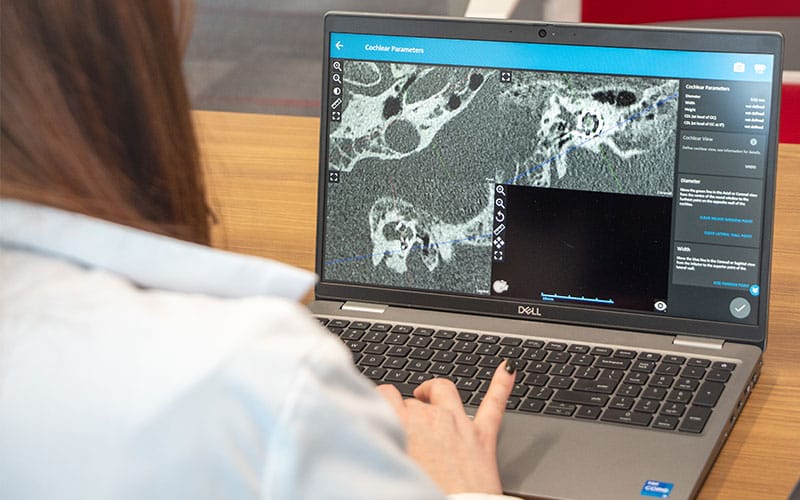Published Jan 25, 2024
Getting Started with OTOPLAN On Demand

We know clinic efficiency remains important to you and your practice, and that’s the reason we made it our priority, too. OTOPLAN* software takes cochlear implant surgical planning to the next level with innovative features, including:
- Detailed 3D anatomy images
- Patient-specific electrode visualization
- Automatic contact detection
- Anatomy-Based Fitting support
With OTOPLAN On Demand, the power of OTOPLAN is more accessible than ever before.
We designed OTOPLAN On Demand as a free service to bring OTOPLAN’s benefits to your clinic in an easy-to-use way. Simply send us your patient’s scans, and our trained experts will perform the analysis for you. Shortly after that, you will receive the detailed analysis report to 1) aid you in selecting the MED-EL electrode you feel best fits your patient’s cochlea† and/or 2) contact identification and file attachment for the Anatomy-Based Fitting.
OTOPLAN On Demand includes preoperative and postoperative analyses.
Preoperative Analysis
We will measure your patient’s cochlear duct length and provide visualization of each FLEX series electrode to help you determine which variant best fits your patient’s unique cochlea. Pre-op analysis requires your patient’s CT or MRI scans following the appropriate imaging guidelines.
- Measure the patient’s Cochlear Duct Length
- Visually evaluate the anticipated position of each FLEX electrode variant
Postoperative Analysis
We will analyze your patient’s CT scan to determine electrode insertion status and the exact location of each electrode contact. OTOPLAN will generate a file that you can easily import into MAESTRO fitting software‡ to apply customized Anatomy-Based Fitting adjustments to your patient’s maps.
- Evaluate electrode insertion status
- Identify angular insertion depth & tonotopic location of each individual electrode contact
Do you have a patient that is not hearing as well as expected, or is unhappy with their sound quality? Discuss obtaining a postoperative CT scan and using OTOPLAN and Anatomy-Based Fitting to optimize their listening experience.
The Impact
Research indicates cochlear duct lengths range from 30.7-42.2mm.Meng, J., Li, S., Zhang, F., Li, Q., & Qin, Z. (2016). Cochlear Size and Shape Variability and Implications in Cochlear Implantation Surgery. Otology & neurotology : official publication of the American Otological Society, American Neurotology Society [and] European Academy of Otology and Neurotology, 37(9), 1307–1313. https://doi.org/10.1097/MAO.0000000000001189[1] MED-EL is the only cochlear implant company with multiple electrode lengths to accommodate your patient’s precise cochlear anatomy to achieve complete cochlear coverage.
If an electrode does not cover two turns of the cochlea at minimum, it cannot provide an accurate pitch-place match, resulting in a robotic, tinny, or mechanical sound quality for the patient.
"I've been working with implants for 34 years, and this is the first time that I really feel like we're able to approach it from an objective, technical perspective and that we have tools that we've never had before."
Michelle L Montes
AU.D., University of Pennsylvania Health System
Getting Started is Simple
1. Define Roles
Determine who will be the point person for submitting requests and scans. This can be an audiologist, surgeon, coordinator, or someone else within your practice.
2. Obtain the Scans
This process varies at each clinic. There are a few ways you can receive the scans.
- CD from radiology – This is the most straightforward, fool-proof method to obtain the files
- EMR or PACS – With IT or radiology support, export/extract the scans.
- Cloud-based site – Download the files to your local machine.
Do you need help getting started? Contact otoplan.us@medel.com.
3. Fill Out the Request Form.
Visit otoplanondemand.com to access the form. Once the form is completed, a link to Box will be emailed to you with instructions.

4. Securely Upload the Scans for MED-EL
After verifying that your scans meet the imaging requirements, zip the entire DICOM file, and upload the scans into the HIPPA-compliant Box link. If Box is not accessible at your institution, please contact our staff at 888.633.3524 or otoplan.us@medel.com.
5. Receive Detailed Analysis
Within two business days, you will receive an encrypted email with the detailed analysis report.
6. Make the Decisions
Use the detailed report to counsel your MED-EL patients to help them achieve better outcomes. After selecting and implanting the appropriate MED-EL electrode for your patient’s cochlear duct length, you will have the option to customize their hearing experience using Anatomy-Based Fitting once your patient begins using the device.

Now what?
OTOPLAN helps you visualize your patients’ unique cochleae and select the right MED-EL electrode for them. We all want recipients to hear the best they possibly can—and as natural as possible. Medicine constantly changes and improves with new research and more technology becoming available, so it is important to continue seeking ways to improve your practice.
With MED-EL’s free OTOPLAN On Demand service, surgeons and audiologists enjoy easy access to their patient’s individualized OTOPLAN analysis and detailed reports to support preoperative electrode selection and postoperative Anatomy-Based Fitting.
Reach out to your local MED-EL team about implementing OTOPLAN On Demand today.
* OTOPLAN is a product of CASCINATION AG.
† OTOPLAN functions are not indicated for use with abnormal or malformed cochlea. The information displayed in OTOPLAN compares MED-EL electrode parameters to a patient’s estimated cochlear anatomy. The software and analysis report do not select or recommend a specific electrode array. Responsibility for electrode selection rests solely with the health care professional. Furthermore, frequency estimates displayed in OTOPLAN are based on the estimated position of a patient’s electrode array and may not reflect patient perception. Frequency estimates and Anatomy-Based Fitting are pieces of clinical information the audiologist may choose to incorporate into the overall cochlear implant mapping procedure for an individual patient. OTOPLAN is not meant to replace the professional judgment of experienced health care providers.
‡ MAESTRO Cochlear Implant Fitting Software version 9.0.5 or later is required.
References
-
[1]
Meng, J., Li, S., Zhang, F., Li, Q., & Qin, Z. (2016). Cochlear Size and Shape Variability and Implications in Cochlear Implantation Surgery. Otology & neurotology : official publication of the American Otological Society, American Neurotology Society [and] European Academy of Otology and Neurotology, 37(9), 1307–1313. https://doi.org/10.1097/MAO.0000000000001189
Want additional resources on this topic?
AudiologyOnline | Anatomy-Based Fitting: Matching the Natural Ear Like Never Before
OTOPLAN On Demand | OTOPLANOnDemand.com
OTOPLAN | OTOPLAN Is Now Available (medel.com)
References
Was this article helpful?
Thanks for your feedback.
Sign up for newsletter below for more.
Thanks for your feedback.
Please leave your message below.
Thanks for your message. We will reply as soon as possible.
Send Us a Message
Field is required
John Doe
Field is required
name@mail.com
Field is required
What do you think?
© MED-EL Medical Electronics. All rights reserved. The content on this website is for general informational purposes only and should not be taken as medical advice. Contact your doctor or hearing specialist to learn what type of hearing solution suits your specific needs. Not all products, features, or indications are approved in all countries.



